The AMD Radeon RX 5500 XT Review, Feat. Sapphire Pulse: Navi For 1080p
by Ryan Smith on December 12, 2019 9:00 AM ESTPower, Temperature, & Noise
Last, but not least of course, is our look at power, temperatures, and noise levels. While a high performing card is good in its own right, an excellent card can deliver great performance while also keeping power consumption and the resulting noise levels in check.
| Radeon Video Card Voltages | |||||
| 5700 Max | 5500 XT Max | 5700 Idle | 5500 XT Idle | ||
| 1.025v | 1.141v | 0.775v | 0.700v | ||
Back when the RX 5700 series launched, AMD’s voltages surprised me; the RX 5700 XT went as high as 1.2v on TSMC’s 7nm process. For better or worse, it looks like those voltages aren’t a fluke, as we see high voltages with the RX 5500 XT as well. In this case the card tops out at 1.141v, a not insubstantial decrease from the RX 5700 XT, though it’s still relatively high. AMD’s GPUs are still the only high-throughput GPU-like product we’ve seen voltages for on this process, so it’s hard to say whether this is a TSMC thing or an AMD thing. But either way, as AMD’s own voltage/frequency curve helpfully illustrates, the last couple of hundred MHz on the RX 5500 XT gets to be quite expensive in terms of power.
| Radeon Video Card Average Clockspeeds (Rounded to the Nearest 10MHz) |
|||
| Game | 5500 XT | 5700 | |
| Max Boost Clock | 1860MHz | 1750MHz | |
| Official Game Clock | 1717MHz | 1625MHz | |
| Tomb Raider | 1810MHz | 1680MHz | |
| F1 2019 | 1810MHz | 1650MHz | |
| Assassin's Creed | 1750MHz | 1700MHz | |
| Metro Exodus | 1800MHz | 1640MHz | |
| Strange Brigade | 1840MHz | 1660MHz | |
| Total War: TK | 1840MHz | 1690MHz | |
| The Division 2 | 1800MHz | 1630MHz | |
| Grand Theft Auto V | 1830MHz | 1690MHz | |
| Forza Horizon 4 | 1830MHz | 1700MHz | |
Despite that power cost, however, the RX 5500 XT manages to keep its clockspeeds rather high. Even without Sapphire’s higher power cap performance BIOS, their 8GB card is frequently at 1800MHz or better, putting it well ahead of AMD’s official game clock of 1717MHz. This means the card is running fairly close to its clockspeed limit – so Sapphire’s extra power doesn’t do a whole lot – but it also means the card is doing all of this on 130W (or less) of power.
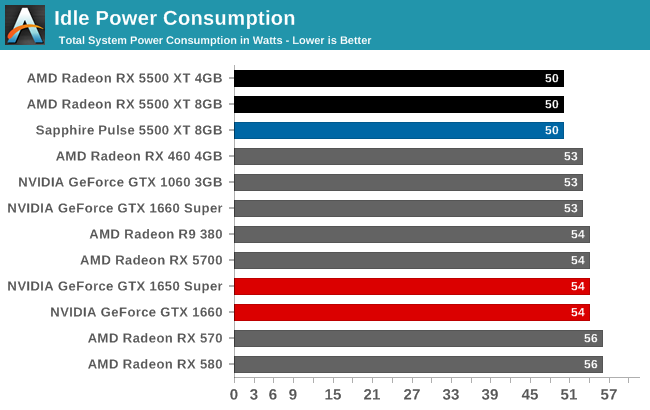
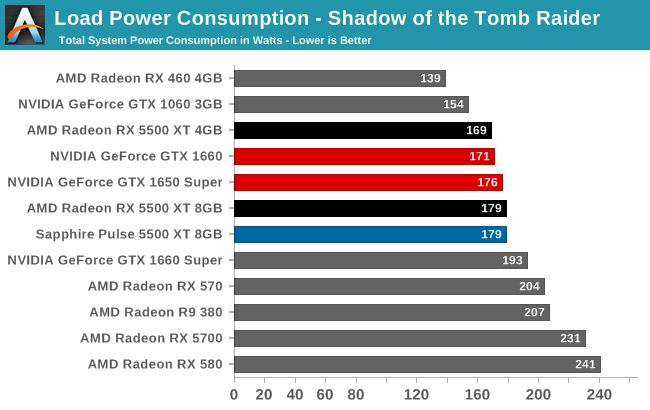
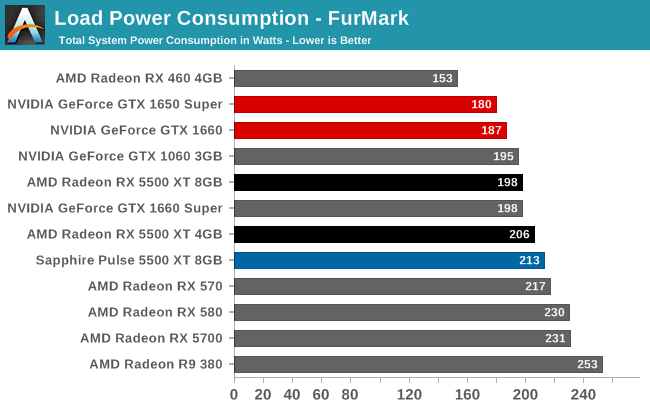
With the combination of TSMC’s 7nm process, AMD’s firmware optimizations, and I suspect the use of just 8 PCIe lanes, the RX 5500 XT fares very well when it comes to idle power. At 50W for the entire system, this is lower than any other configuration by a few watts. Which for idling, where power consumption is already low, is huge. No wonder Sapphire is able to offer zero fan speed idle here; the card is burning very little power at idle.
Similarly, load power is looking fairly good as well. Under Tomb Raider, the total system power consumption with the AMD cards is highly competitive with the NVIDIA competition (though as we’ve seen, actual game framerates trail a bit). Though AMD does fall behind under FurMark, as the 130W+ RX 5500 XT cards all have higher TDPs than NVIDIA’s 120W/125W equivalents, and FurMark will drive all of these cards to their power limits.
In practice, all of this generally reflects the cards’ relative specifications. The RX 5500 XT is able to hang with the somewhat inefficient GTX 1650 Super, however once we get to the more efficient GTX 1660, NVIDIA is consuming less power while delivering better performance.
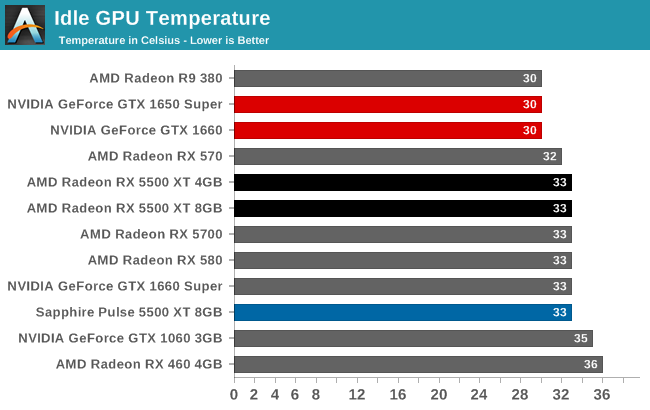


Early on I mentioned that Sapphire’s Pulse cards might be a bit overbuilt, and now that we’re getting into temperature and noise measurements, we get to see why. The idle GPU temperatures are what we’d expect for a zero fan speed idle card; meanwhile the load temperatures don’t crack 70C under Tomb Raider, and even FurMark only pushes the worst card to a well within tolerances 76C.
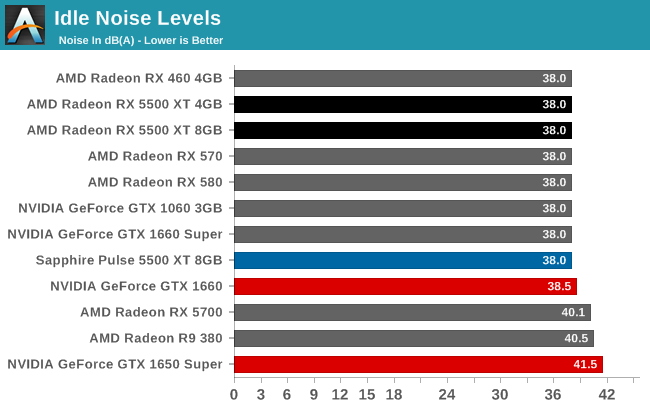
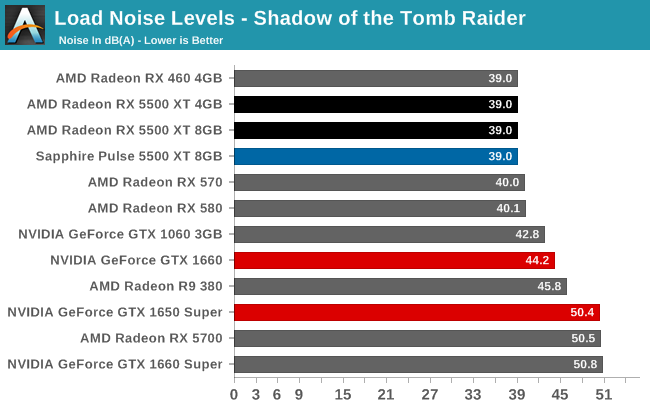
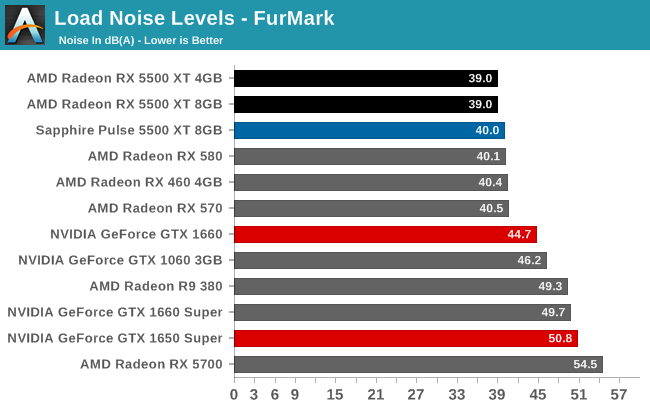
But when we get to noise, this is where Sapphire blows our socks off. Or rather, doesn’t blow our socks off?
The load noise levels I measured here were so low that it required extra effort to properly duplicate the results and isolate noise sources. With a card TDP of 130W, those big 95mm fans end up doing very little work. The PWM and monitoring-enabled fans run at under 800 RPM on gaming workloads, and it’s only when we’re using Sapphire’s higher TDP performance BIOS that the fans crack 1000 RPM.
Sapphire could probably cool a 200W card with this cooler, and I wouldn’t be too surprised to learn that it’s exactly such a card they took it from. But the net result is that while the card is a space hog, it’s a silent space hog. With load noise levels below 40 dB(A) for everything except FurMark, the card is barely louder than the rest of the system. Compared to our GeForce cards, all of which are smaller cards with equally small fans, the difference is extensive. Sapphire may have overbuilt their card, but as a result they’ve struck a great balance between temperatures and cooling performance, and delivering great acoustics in the process.


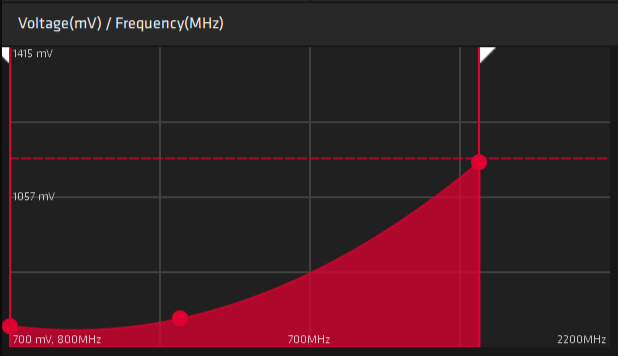








97 Comments
View All Comments
eva02langley - Thursday, December 12, 2019 - link
Also, more wattage for a system that use less than 50% of the load will results in poor efficiency which you don't want to do.silverblue - Friday, December 13, 2019 - link
As it is, the 590 is slightly more efficient than the 580 per clock, but a minor undervolt will yield further savings. I have a TX650M which is severe overkill for a Ryzen 5 1600, 16GB DDR4 3000 and Sapphire Nitro+ RX590, which is undervolted by 8% and doesn't go above 1.1V.PeachNCream - Friday, December 13, 2019 - link
For a single CPU socket and single GPU, buying a 500W PSU is more than reasonable. You are falling into the more is better trap by probably spending more money an losing efficiency by getting something in the +750W range. That sounds like something a person that has not done any research would suggest.29a - Friday, December 13, 2019 - link
I wish they would start testing the codec ASIC on GPUs.SethNW - Thursday, December 12, 2019 - link
RX5500XT has one issue, it is the ok card. Like it is not terrible, but older RX580/590 are just too close to irlt and with prices dropping, they make more sense. And 8GB end, add a little and you get better performing 1660 or what is in a lot of cases tiny bit more and you got 1660 Super. I don't think extra 2GB of VRAM will make that huge difference at 1080p, 4GB definitely is budget category, but 6GB is doable for next 3 years. But only time will tell whether bandwidth or size will matter more.Ravynmagi_ - Thursday, December 12, 2019 - link
I was very torn up about what to buy. I wanted to stay in the $160-$180 range. I just play a couple games that are not too demanding (Civ 6 and Albion Online).I tried an RX 580, but mine has really bad coil noise. So I went with a GTX 1650. It's working perfectly for my games on a 1440p monitor.
I was uncertain if I should have waited for the RX 5500 XT. I see now it seems to provide equal performance more or less and I do prefer Nvidia drivers over AMD. So this seems to work out for me.
A part of my still nags that I should have tried another RX 580 or 590 with 8GB of RAM. But this is an entry level gaming card. If I get into more demanding games I would most likely replace whatever I bought in this price range eventually anyway before I need the 8GB of RAM I suspect.
Ravynmagi_ - Thursday, December 12, 2019 - link
Looks like I can't edit my comment. But meant to say GTX 1650 Super.eva02langley - Thursday, December 12, 2019 - link
Yeah, makes mroe sense since the 1650 GTX is a total disaster.Hrel - Thursday, December 12, 2019 - link
Looks like I'm stuck waiting for a significant price drop. I'd like to update my 280x, but it runs everything I play so the only real reason is power efficiency and system thermals. Things literally a space heater when gaming.I'm really just looking for 280x performance + 50% or so, which 1650 super does, 5500xt does, but to pay nearly $200 just to knock 75 watts off my system.... Does not appeal. Especially when the 4gb vram issue is real.
280x has 3GB ram, my system monitors have shown it tapping system ram. Not a lot, and the newest game I play is dark souls 3, 500MB. But I'm pretty sure DS3 is from 2013.
Assuming a new game that isn't esports like rocket league comes out that I want, I'd like this card to run it well.
Maybe that means I'm waiting another 2 to 4 years to replace my card. Maybe it just means waiting till next gen comes out and getting deals on these.
Either way, this generation isn't enough. From either camp.
cmdrmonkey - Thursday, December 12, 2019 - link
You already have so many other cards that are around this level of performance that I'm not sure why we needed another one. GTX 970, 1060, 1650 Super, RX 470, 480, 570, 580, 590 are all in the same ballpark as this thing depending on the game. Why did we need this? Seems like this performance segment is totally tapped out.